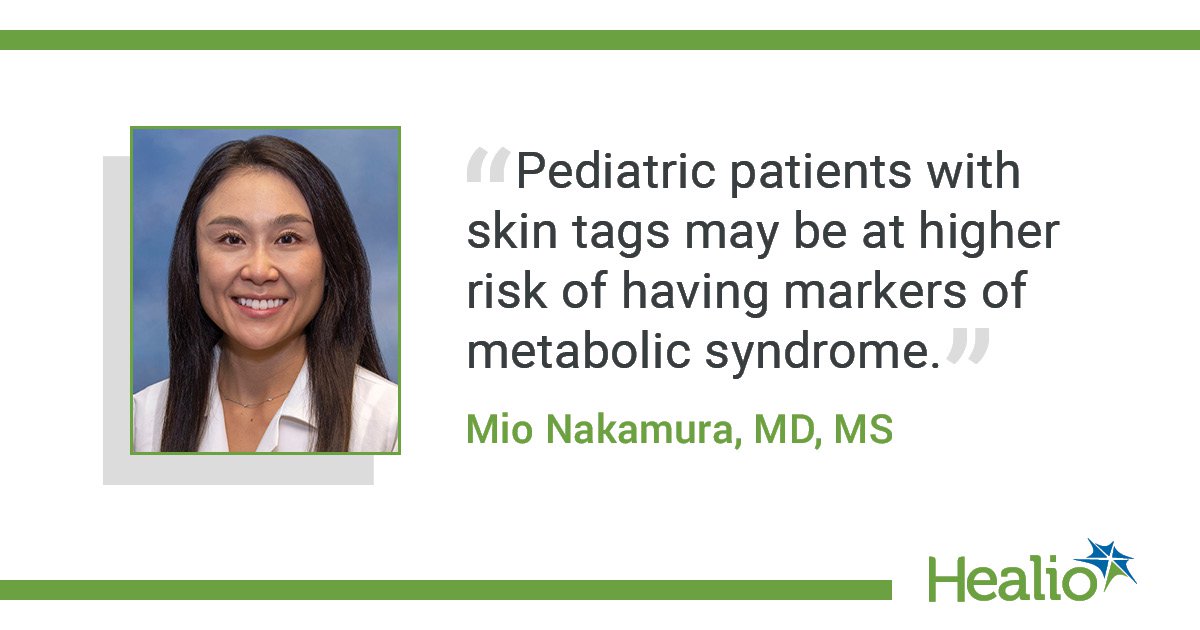Key takeaways:
- Pediatric patients with acrochordons, or skin tags, are more likely to be overweight or obese.
- These patients are also more likely to have type 2 diabetes, hyperlipidemia and hypertension.
Acrochordons, also known as skin tags or fibroepithelial polyps, are correlated with metabolic disease and obesity in pediatric patients, according to a study.
“Previous studies in adults have shown a correlation between skin tags and metabolic syndrome,” Mio Nakamura, MD, MS, assistant professor and director of the Program for Clinical Research in Dermatology at the University of Michigan and one of the study’s authors, told Healio. “This is the first study to my knowledge that looks at a large group of pediatric patients with skin tags and association with various markers of metabolic syndrome such as obesity, diabetes, hyperlipidemia and hypertension.”

Researchers conducted a single-center retrospective cohort study including 55 pediatric patients (mean age, 10.1 years; 64% girls; 76% white) with acrochordons.
BMI was reported in 51 of the subjects (mean BMI, 27.3 kg/m2). There were 25 (49%) patients with obesity and 10 (20%) with overweight.
Hypothyroidism was present in two (3.6%), polycystic ovary syndrome in four (7.3%) and type 2 diabetes in three (5.5%) of the total study population.
Full laboratory workups including triglycerides, HDL, fasting glucose and blood pressure were completed in six patients with overweight and 15 patients with obesity.
In the cohorts with obesity and overweight, elevated triglycerides were found in 11 and two patients, respectively, and high blood pressure in eight and one. Low HDL and elevated fasting glucose were recorded in seven and two patients in the group with obesity.
Using data from a matched cohort from the National Health and Nutrition Examination Survey dataset found many metabolic disease comorbidities to be more prevalent in the study cohort, including obesity (49% vs. 27%), type 2 diabetes (5.5% vs. 1.9%), hyperlipidemia (7.3% vs. 0%) and hypertension (1.8% vs. 0%). Additionally, a higher median BMI (27 kg/m2 vs. 20 kg/m2; P < .001), triglycerides (120 mg/dL vs. 74 mg/dL; P = .011), aspartate transaminase (23 units/L vs. 18 units/L; P = .005) and alanine transaminase (26 units/L vs. 10 units/L; P < .001) were all recorded in the study population compared with the propensity-matched cohort.
Median high-density lipoprotein was also significantly lower in the acrochordons group (46 mg/dL vs. 54 mg/dL; P = .019).
These results are similar to what has previously been found in adult patients.
“Pediatric patients with skin tags may be at higher risk of having markers of metabolic syndrome such as obesity, type 2 diabetes, hyperlipidemia and hypertension compared to the general population,” Nakamura told Healio. “Although more data are needed, screening for metabolic syndrome in children with skin tags may lead to earlier diagnosis or prevention of metabolic syndrome. “
